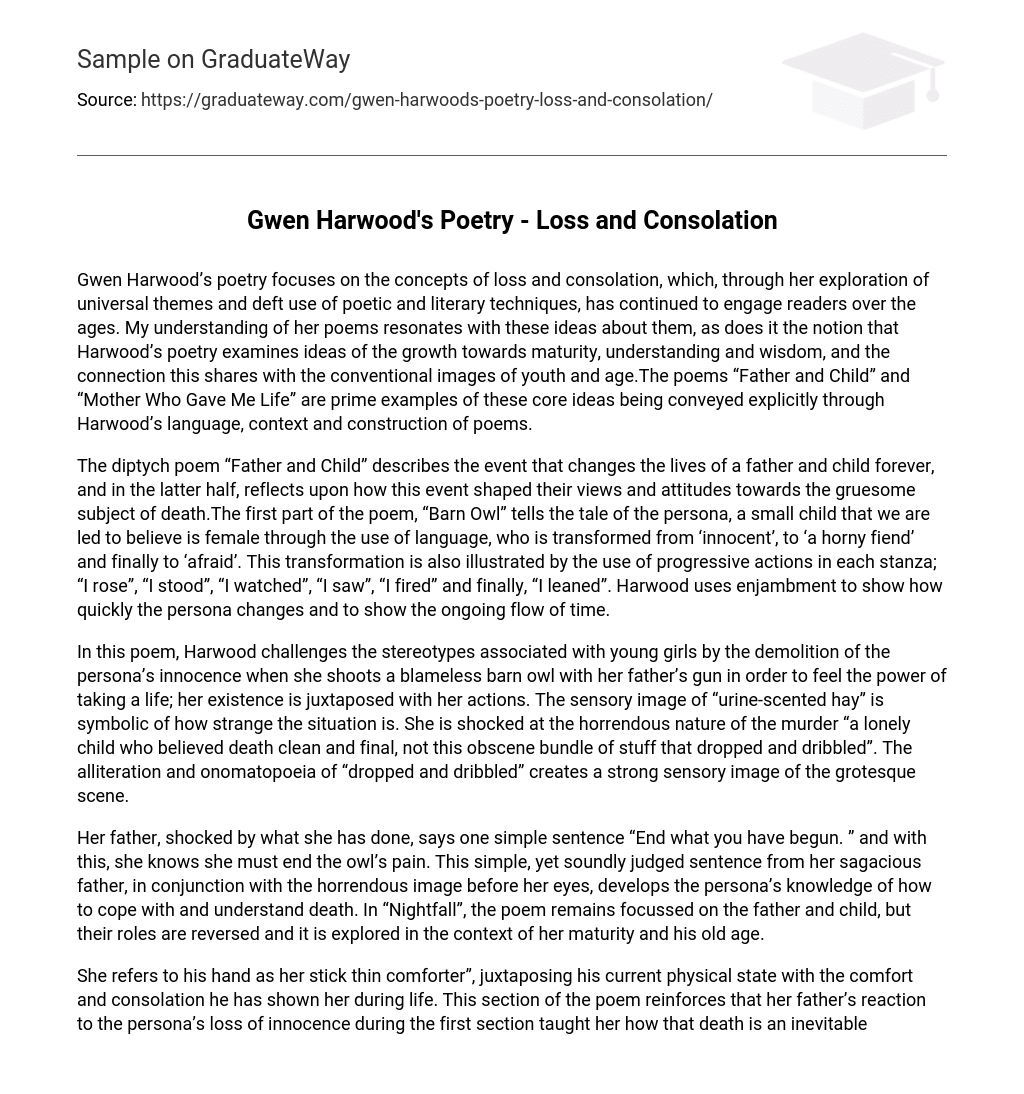Gwen Harwood’s poetry focuses on the concepts of loss and consolation, which, through her exploration of universal themes and deft use of poetic and literary techniques, has continued to engage readers over the ages. My understanding of her poems resonates with these ideas about them, as does it the notion that Harwood’s poetry examines ideas of the growth towards maturity, understanding and wisdom, and the connection this shares with the conventional images of youth and age.The poems “Father and Child” and “Mother Who Gave Me Life” are prime examples of these core ideas being conveyed explicitly through Harwood’s language, context and construction of poems.
The diptych poem “Father and Child” describes the event that changes the lives of a father and child forever, and in the latter half, reflects upon how this event shaped their views and attitudes towards the gruesome subject of death.The first part of the poem, “Barn Owl” tells the tale of the persona, a small child that we are led to believe is female through the use of language, who is transformed from ‘innocent’, to ‘a horny fiend’ and finally to ‘afraid’. This transformation is also illustrated by the use of progressive actions in each stanza; “I rose”, “I stood”, “I watched”, “I saw”, “I fired” and finally, “I leaned”. Harwood uses enjambment to show how quickly the persona changes and to show the ongoing flow of time.
In this poem, Harwood challenges the stereotypes associated with young girls by the demolition of the persona’s innocence when she shoots a blameless barn owl with her father’s gun in order to feel the power of taking a life; her existence is juxtaposed with her actions. The sensory image of “urine-scented hay” is symbolic of how strange the situation is. She is shocked at the horrendous nature of the murder “a lonely child who believed death clean and final, not this obscene bundle of stuff that dropped and dribbled”. The alliteration and onomatopoeia of “dropped and dribbled” creates a strong sensory image of the grotesque scene.
Her father, shocked by what she has done, says one simple sentence “End what you have begun. ” and with this, she knows she must end the owl’s pain. This simple, yet soundly judged sentence from her sagacious father, in conjunction with the horrendous image before her eyes, develops the persona’s knowledge of how to cope with and understand death. In “Nightfall”, the poem remains focussed on the father and child, but their roles are reversed and it is explored in the context of her maturity and his old age.
She refers to his hand as her stick thin comforter”, juxtaposing his current physical state with the comfort and consolation he has shown her during life. This section of the poem reinforces that her father’s reaction to the persona’s loss of innocence during the first section taught her how that death is an inevitable part of life. Now that his is becoming imminent, she is prepared for the loss of her comforter because of his prior actions. Intertextual references to King Lear are made in the line “no more to taste/ripeness is plainly all”, stating that his time has come at the ‘ripe’ age of eighty years and there is nothing more in life he needs to experience.
This is a source of consolation for both the persona and her father. In ‘Mother Who Gave Me Life”, through the expert use of a variety of structural and language techniques, Gwen Harwood is able to portray the journey through growth to maturity, wisdom and understanding, from loss towards consolation. The composition is an address to the persona’s deceased mother, thus taking the form of an elegy; a poem of mourning presented in a respectful tone. In “Mother Who Gave Me Life”, Harwood employs a formal tone and chooses not to use a traditional poetic structure, perhaps to make the poem more personal.
The persona refers to her mother in an extended metaphor of a piece of fabric, which represents her mother in different stages at her life. This begins with her ‘folding a little towel’ at her time of death, which is symbolic of the way she has continuously served others. She then calls her mother “a fabric of marvels folded down to a little space”, which refers to the marvels she accomplished during her short life, but can also be interpreted as her metaphorically large heart being ‘folded down’ into her small body.Her face ‘crumples’ like ‘fine linen’ because of it’s fine lines but also its delicacy and in the ‘remembered hours’ she is represented by a beautifully embroidered linen, which both physically and emotionally representative of her mother’s youth.
•Enjambment is frequently employed, which gives the poem a sense of continuity and contributes to the sombre, flowing atmosphere of the poem, and represents the continual and inevitable passage of time and evolutionary change. Sibilance is used to create a calm, melancholy tone “worn still, good to the last”, “somehow, smooth to a smile so I should not see your tears.Anguish. Remembered hours.
” This line is also symbolic of her mother’s consolation of her daughter, even in death. The shift from past tense to present tense is yet another literary technique utilised by Harwood to explore and portray the journey to wisdom and consolation from naivety and loss, “…Forgive me the wisdom I would not learn from you. ” Progressive action is also used in “Mother Who Gave Me Life” which provides a further sense of continuity, development and passage between loss and consolation through the persona’s realisation and acceptance of death.





